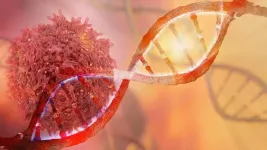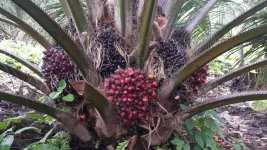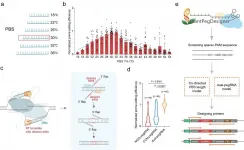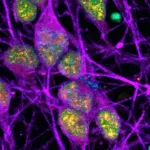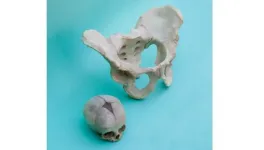New discoveries of deep brain simulation put it on par with therapeutics
Possibly speeding the process and allowing personalized treatment
2021-03-25
(Press-News.org) Despite having remarkable utility in treating movement disorders such as Parkinson's disease, deep brain stimulation (DBS) has confounded researchers, with a general lack of understanding of why it works at some frequencies and does not at others. Now a University of Houston biomedical engineer is presenting evidence in Nature Communications Biology that electrical stimulation of the brain at higher frequencies (>100Hz) induces resonating waveforms which can successfully recalibrate dysfunctional circuits causing movement symptoms.
"We investigated the modulations in local ?eld potentials induced by electrical stimulation of the subthalamic nucleus (STN) at therapeutic and non-therapeutic frequencies in Parkinson's disease patients undergoing DBS surgery. We ?nd that therapeutic high-frequency stimulation (130-180 Hz) induces high-frequency oscillations (~300 Hz, HFO) similar to those observed with pharmacological treatment," reports Nuri Ince, associate professor of biomedical engineering.
For the past couple of decades, deep brain stimulation (DBS) has been the most important therapeutic advancement in the treatment of Parkinson's disease, a progressive nervous system disorder that affects movement in 10 million people worldwide. In DBS, electrodes are surgically implanted in the deep brain and electrical pulses are delivered at certain rates to control tremors and other disabling motor signs associated with the disease.
Until now, the process to find the correct frequency has been time consuming, with it taking sometimes months to implant devices and test their abilities in patients, in a largely back and forth process. Ince's method may speed the time to almost immediate for the programming of devices at correct frequencies.
"For the first time, we stimulated the brain and while doing that we recorded the response of the brain waves at the same time, and this has been a limitation over the past years. When you stimulate with electrical pulses, they generate large amplitude artifacts, masking the neural response. With our signal processing methods, we were able to get rid of the noise and clean it up," said Ince. "If you know why certain frequencies are working, then you can adjust the stimulation frequencies on a subject-specific basis, making therapy more personalized."
INFORMATION:
DBS is also being explored for the treatment of many other neurological and psychiatric indications, including Obsessive-Compulsive Disorder.
Additional authors of the article are Ince's doctoral student Musa Ozturk; and Ashwin Viswanathan and Sameer Sheth, Baylor College of Medicine.
[Attachments] See images for this press release:

ELSE PRESS RELEASES FROM THIS DATE:
2021-03-25
LA JOLLA--The glow of a panther's eyes in the darkness. The zig-zagging of a shark's dorsal fin above the water.
Humans are always scanning the world for threats. We want the chance to react, to move, to call for help, before danger strikes. Our cells do the same thing.
The innate immune system is the body's early alert system. It scans cells constantly for signs that a pathogen or dangerous mutation could cause disease. And what does it like to look for? Misplaced genetic material.
The building blocks of DNA, called nucleic acids, are supposed to be hidden away in the cell nucleus. Diseases can change that. Viruses churn out genetic material in parts of the cell where it's not supposed to be. Cancer cells do too.
"Cancer cells harbor damaged DNA," says ...
2021-03-25
New clues to a long-pursued drug target in cancer may reside within immune cells, researchers at the University of Michigan Rogel Cancer Center have discovered.
The findings, which appear in Nature Immunology, not only shed new light on cancer immunology, they also suggest clinical trials related to this key target -- an interaction that destabilizes the important p53 tumor suppressor protein -- may unnecessarily be excluding a large number of patients.
The researchers are optimistic that the findings could help make immunotherapy treatment more effective against ...
2021-03-25
CORVALLIS, Ore. - Warm river habitats appear to play a larger than expected role supporting the survival of cold-water fish, such as salmon and trout, a new Oregon State University-led study published today found.
The research has important implications for fish conservation strategies. A common goal among scientists and policymakers is to identify and prioritize habitat for cold-water fish that remains suitably cool during the summer, especially as the climate warms.
This implicitly devalues areas that are seasonally warm, even if they are suitable for fish most of the year, said Jonny Armstrong, lead author of the paper and an ecologist at Oregon State. He called this a "potentially severe blind spot for climate change adaptation."
"Coldwater ...
2021-03-25
Lithium-ion batteries have made possible the lightweight electronic devices whose portability we now take for granted, as well as the rapid expansion of electric vehicle production. But researchers around the world are continuing to push limits to achieve ever-greater energy densities -- the amount of energy that can be stored in a given mass of material -- in order to improve the performance of existing devices and potentially enable new applications such as long-range drones and robots.
One promising approach is the use of metal electrodes in place of the conventional graphite, with a higher charging ...
2021-03-25
Many psychiatric disorders have genetic causes, but the exact mechanism of how genes influence higher brain function remains a mystery. A new study provides a map linking the genetic signature of functions across the human brain, a tool that may provide new targets for future treatments.
Led by Bratislav Misic, a researcher at The Neuro (Montreal Neurological Institute-Hospital) of McGill University, a group of scientists performed machine learning analysis of two Open Science datasets: the gene expression atlas from the Allen Human Brain Atlas and the functional ...
2021-03-25
DURHAM, N.C. - Engineers at Duke University have developed an electronics-free, entirely soft robot shaped like a dragonfly that can skim across water and react to environmental conditions such as pH, temperature or the presence of oil. The proof-of-principle demonstration could be the precursor to more advanced, autonomous, long-range environmental sentinels for monitoring a wide range of potential telltale signs of problems.
The soft robot is described online March 25 in the journal Advanced Intelligent Systems.
Soft robots are a growing trend in the industry due to their versatility. Soft parts can handle delicate objects such as biological tissues that metal or ceramic components would damage. Soft bodies can help robots float or squeeze into tight spaces where rigid ...
2021-03-25
Lincoln, Neb., March 25, 2021 -- Palm oil, the most important source of vegetable oil in the world, is derived from the fruit of perennial palm trees, which are farmed year-round in mostly tropical areas. The palm fruit is harvested manually every 10 days to two weeks, then transported to a mill for processing, and ultimately exported and made into a dizzying array of products from food to toiletries to biodiesel.
"You probably ate palm oil for breakfast," said Patricio Grassini, an associate professor of agronomy at the University of Nebraska-Lincoln. "There is probably palm oil in your ...
2021-03-25
Precision genome editing enables the precise modification of DNA in living cells, thus enabling a breadth of opportunities for plant breeding. Prime editors, developed by Prof. David R. Liu and his colleagues, permit the installation of desired edits in a programmable target site. They are comprised of an engineered Cas9 nickase (H840A)-reverse transcriptase (RT) fusion protein and a prime editing guide RNA (pegRNA).
Prime editors were previously developed and optimized as an extremely versatile editing strategy for generating programmable point mutations, insertions and deletions in rice and wheat by Prof. GAO Caixia of the Institute of Genetics and Developmental Biology (IGDB) of the Chinese Academy of Sciences ...
2021-03-25
Researchers at the National Institutes of Health (NIH) have discovered specific regions within the DNA of neurons that accumulate a certain type of damage (called single-strand breaks or SSBs). This accumulation of SSBs appears to be unique to neurons, and it challenges what is generally understood about the cause of DNA damage and its potential implications in neurodegenerative diseases.
Because neurons require considerable amounts of oxygen to function properly, they are exposed to high levels of free radicals--toxic compounds that can damage DNA within cells. ...
2021-03-25
Fossil remains of the human pelvis are rare because the pelvic bones do not preserve very well. Therefore, it has remained unclear when human sex differences in the pelvis evolved: jointly with upright walking, or later, together with the large human brains. "We have discovered that the pattern of sex differences in the human pelvis is probably much older than previously thought", says evolutionary biologist Barbara Fischer.
A team of biologists from the University of Vienna, the KLI for Evolution and Cognition Research, and the University of Calgary compared pelvic sex differences in humans with those in chimpanzees, the most closely-related living species to modern ...
LAST 30 PRESS RELEASES:
[Press-News.org] New discoveries of deep brain simulation put it on par with therapeutics
Possibly speeding the process and allowing personalized treatment

